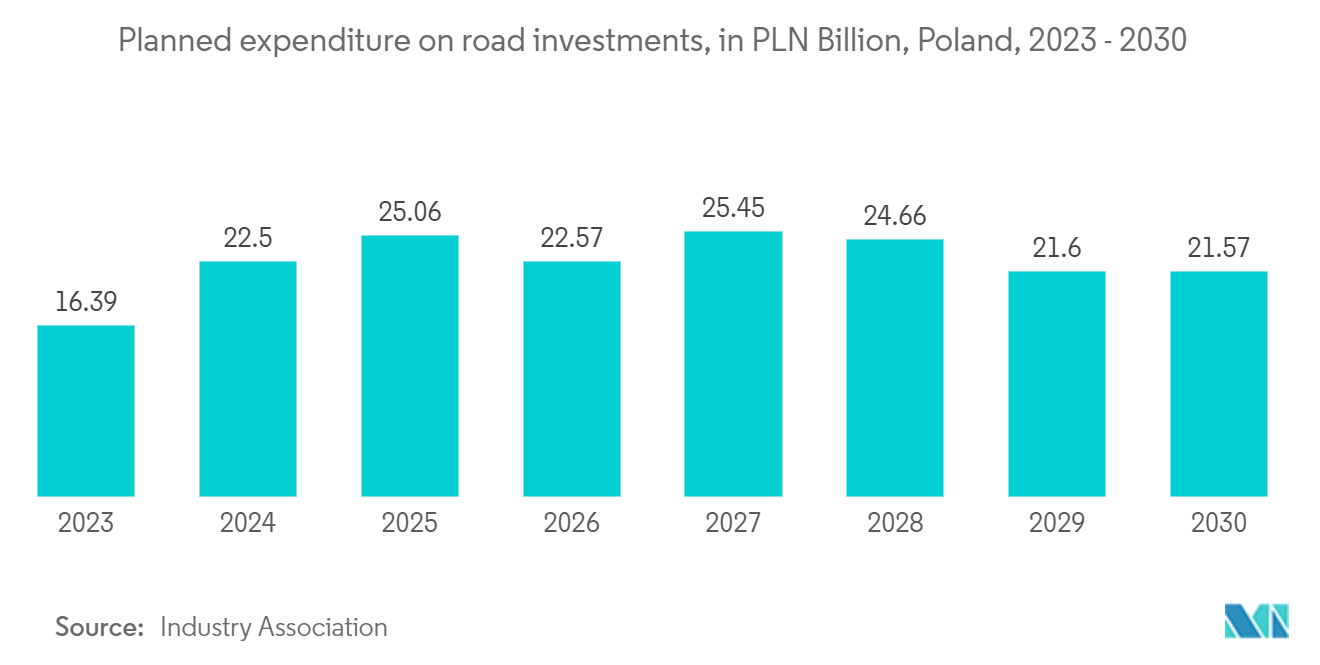Market Trends of Europe Transportation Infrastructure Construction Industry
Increasing investments in the Transport Infrastructure Segment
In the coming years, Germany is set to witness a surge in its infrastructure growth, driven by increased government spending on transport and broadband initiatives. Moreover, the government's emphasis on structural reforms to enhance public investment access will further bolster this growth.
As part of the 2030 FTIP, Germany's federal government has earmarked a substantial USD147.6 billion for the country's road infrastructure from 2016 to 2030. Out of this, around USD 74.4 billion has been allocated for structural maintenance and infrastructure replacements.
However, there is room for improvement as Germany's road network slipped to 16th in the World Economic Forum's Global Competitiveness Report. To address this, Germany plans to invest a staggering EUR 269.6 billion (USD 299.6 billion) by 2030 to revamp and interconnect its transport infrastructure. Experts caution that Germany risks lagging behind its global peers without such investments.
Highlighting the significance of public funding, the IIC reports that the public sector will directly finance 57.4% of the upcoming construction projects. This heightened infrastructure spending by the German government is expected to bolster the economy and spur business investments.
Poland's commitment to transportation development remains robust. Entities like the General Directorate of National Roads and Motorways (GDDKiA), Polish Railway PKP S.A., Polish Railway Networks (PKP-PLK), Ministry of Economic Development and Technology, and Ministry of Infrastructure spearhead nation-wide or regional projects. Local governments also handle infrastructure initiatives for their respective communities. Several highway, railway, and inland waterway endeavors qualify for EU funding.
In recent years, a standout trend in Poland's transportation landscape has been the swift rise of Intelligent Transport Systems (ITS). These solutions are pivotal to the nation's highway and road infrastructure. As part of the ongoing EU funding program (2014-2023, extending to 2025), the government has earmarked USD 17.5 billion for railway infrastructure and USD 36.6 billion for road infrastructure.

Increasing Infrastructure Developments in France
One of France's main drivers of the infrastructure construction market is the country's commitment to sustainable development and environmental protection. The pressing and rather urgent need for reducing carbon emissions and increasing consumer awareness of climate change are among the primary driving forces behind the rapid growth in the public transportation market.
Additionally, developments in the public transportation sector, such as the widespread adoption of electric buses and trains that are more cost-effective when compared to owning and maintaining a private vehicle, are further encouraging market growth.
Public transport systems provide an equitable and affordable solution for traveling in urban areas to individuals who can not afford or prefer not to bear the expenses associated with private vehicle ownership, which is serving as another significant growth-inducing factor.
In June 2023, Line 10, a conventional tramway similar to Line 9, which debuted in 2021, was inaugurated. Line 10 traverses the inner-suburban region of the department, characterized by a moderate population density as per regional benchmarks.
The Societe du Grand Paris (SGP) is spearheading the Grand Paris Express, the largest transportation endeavor in Paris, France. Once completed, this ambitious project will cater to a staggering three million residents daily. The initiative encompasses the expansion of Line 14 and the construction of four cutting-edge automatic Lines. The construction of these new lines will be phased, culminating in 2030.
With a hefty price tag of EUR 36.1 billion (approximately USD 47.7 billion), the Grand Paris Express is a joint effort. The French Government, via SGP, is shouldering 30% of the investment, while local authorities are financing the remaining 70% through earmarked taxes, subsidies, and loans. Beyond its financial implications, the project holds immense promise for Parisian commuters. By offering swift and comfortable access to the city's attractions and amenities, the Grand Paris Express is set to revolutionize travel within the capital. Furthermore, it is projected to slash carbon dioxide emissions by a staggering 14.2 million tonnes by 2050.


